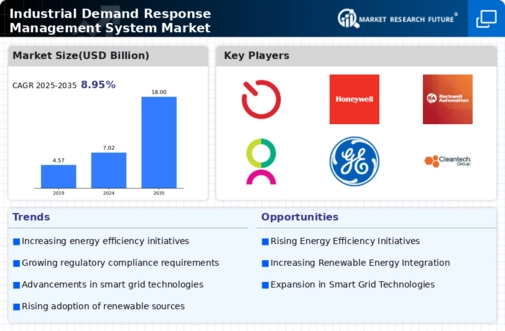The Industrial Demand Response Management System Market is currently characterized by a dynamic competitive landscape, driven by the increasing need for energy efficiency and sustainability across various industrial sectors. Key players such as Schneider Electric (FR), Siemens (DE), and Honeywell (US) are at the forefront, each adopting distinct strategies to enhance their market positioning. Schneider Electric (FR) emphasizes innovation through its EcoStruxure platform, which integrates IoT technology to optimize energy management. Siemens (DE) focuses on digital transformation, leveraging its expertise in automation and smart infrastructure to provide comprehensive demand response solutions. Meanwhile, Honeywell (US) is pursuing strategic partnerships to expand its service offerings, particularly in the realm of smart building technologies, thereby enhancing its competitive edge in the market.
The business tactics employed by these companies reflect a concerted effort to localize manufacturing and optimize supply chains, which are crucial in a moderately fragmented market. This competitive structure allows for a diverse range of solutions tailored to regional needs, fostering innovation and responsiveness among key players. The collective influence of these companies shapes a landscape where agility and technological advancement are paramount, as they strive to meet the evolving demands of industrial clients.
In August 2025, Schneider Electric (FR) announced a partnership with a leading renewable energy provider to enhance its demand response capabilities. This collaboration aims to integrate renewable energy sources into its existing platforms, thereby facilitating a more sustainable energy management approach. The strategic importance of this move lies in its potential to position Schneider Electric as a leader in the transition towards greener energy solutions, aligning with global sustainability goals.
In September 2025, Siemens (DE) launched a new software suite designed to optimize energy consumption in manufacturing processes. This initiative underscores Siemens' commitment to digitalization and its role in driving efficiency within industrial operations. By providing advanced analytics and real-time monitoring, this software is expected to significantly reduce operational costs for clients, thereby reinforcing Siemens' competitive position in the market.
In July 2025, Honeywell (US) expanded its demand response services through the acquisition of a technology startup specializing in AI-driven energy management solutions. This acquisition is strategically significant as it enhances Honeywell's capabilities in predictive analytics, allowing for more proactive energy management strategies. The integration of AI into their offerings is likely to attract a broader client base seeking innovative solutions to energy challenges.
As of October 2025, the competitive trends within the Industrial Demand Response Management System Market are increasingly defined by digitalization, sustainability, and the integration of artificial intelligence. Strategic alliances among key players are shaping the landscape, fostering innovation and collaboration. Looking ahead, it appears that competitive differentiation will evolve from traditional price-based competition to a focus on technological innovation, reliability in supply chains, and the ability to deliver sustainable solutions. This shift may redefine how companies engage with clients, emphasizing the importance of adaptability and forward-thinking strategies in a rapidly changing market.

















Leave a Comment